light switch SKODA OCTAVIA 2007 1.G / (1U) Owner's Guide
[x] Cancel search | Manufacturer: SKODA, Model Year: 2007, Model line: OCTAVIA, Model: SKODA OCTAVIA 2007 1.G / (1U)Pages: 288, PDF Size: 15.19 MB
Page 45 of 288
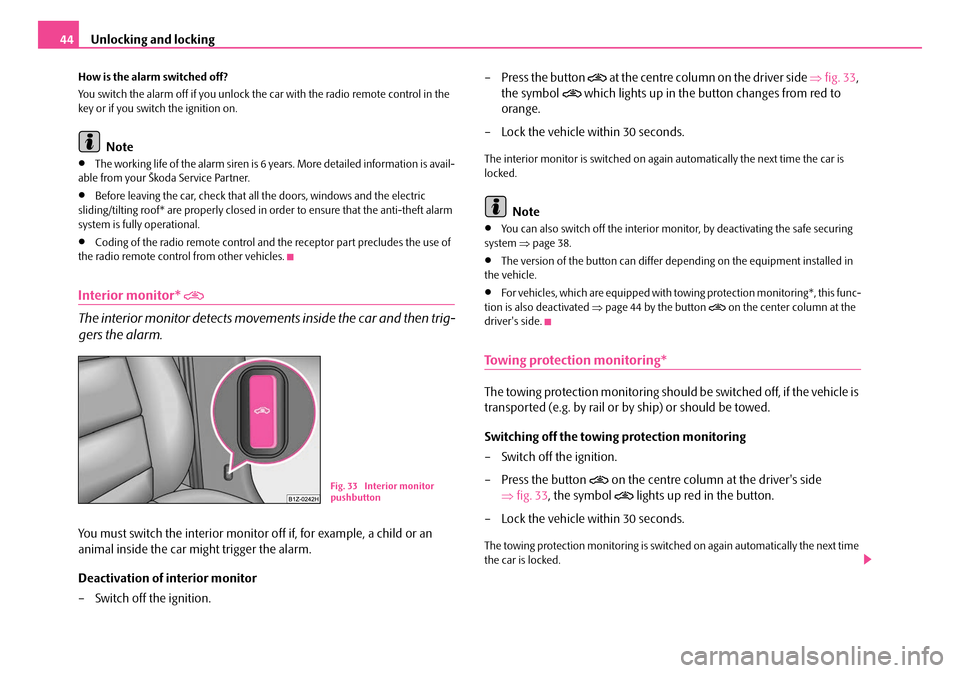
Unlocking and locking
44
How is the alarm switched off?
You switch the alarm off if you unlock the car with the radio remote control in the
key or if you switch the ignition on.
Note
•The working life of the alarm siren is 6 years. More detailed information is avail-
able from your Škoda Service Partner.
•Before leaving the car, check that al l the doors, windows and the electric
sliding/tilting roof* are properly closed in order to ensure that the anti-theft alarm
system is fully operational.
•Coding of the radio remote control and the receptor part precludes the use of
the radio remote control from other vehicles.
Interior monitor*
The interior monitor detects moveme nts inside the car and then trig-
gers the alarm.
You must switch the interior monitor off if, for example, a child or an
animal inside the car might trigger the alarm.
Deactivation of interior monitor
– Switch off the ignition. – Press the button
at the centre c olumn o n the dr iver s ide
⇒fig. 33 ,
the symbol
which lights up in the button changes from red to
orange.
– Lock the vehicle within 30 seconds.
The interior monitor is switched on agai n automatically the next time the car is
locked.
Note
•You can also switch off the interior moni tor, by deactivating the safe securing
system ⇒page 38.
•The version of the button can differ depending on the equipment installed in
the vehicle.
•For vehicles, which are equipp ed with towing protection monitoring*, this func-
tion is also deactivated ⇒page 44 by the button on the center column at the
driver's side.
Towing protection monitoring*
The towing protection monitoring should be switched off, if the vehicle is
transported (e.g. by rail or by ship) or should be towed.
Switching off the towing protection monitoring
– Switch off the ignition.
– Press the button
on the centre column at the driver's side
⇒ fig. 33 , the symbol
lights up red in the button.
– Lock the vehicle within 30 seconds.
The towing protection monitoring is switch ed on again automatically the next time
the car is locked.
Fig. 33 Interior monitor
pushbutton
NKO A5 20 MR08.book Page 44 Wednesday, April 11, 2007 2:54 PM
Page 46 of 288
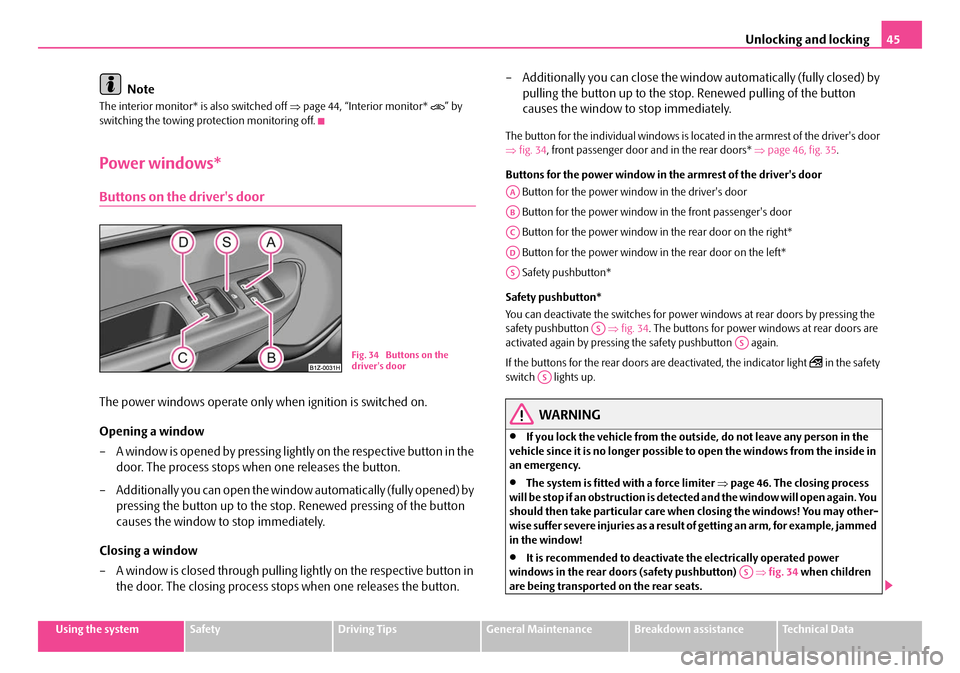
Unlocking and locking45
Using the systemSafetyDriving TipsGeneral MaintenanceBreakdown assistanceTechnical Data
Note
The interior monitor* is also switched off ⇒page 44, “Interior monitor* ” by
switching the towing protection monitoring off.
Power windows*
Buttons on the driver's door
The power windows operate only when ignition is switched on.
Opening a window
– A window is opened by pres sing lightly on the respective butto n in the door. The process stops when one releases the button.
– Additionally you can open the window automatically (fully opened) by pressing the button up to the stop. Renewed pressing of the button
causes the window to stop immediately.
Closing a window
– A window is closed through pulling lightly on the respective button in
the door. The closing process stop s when one releases the button. – Additionally you can close the window automatically (fully closed) by
pulling the button up to the stop. Renewed pulling of the button
causes the window to stop immediately.
The button for the individual windows is lo cated in the armrest of the driver's door
⇒ fig. 34 , front passenger door and in the rear doors* ⇒page 46, fig. 35 .
Buttons for the power window in the armrest of the driver's door Button for the power window in the driver's door
Button for the power window in the front passenger's door
Button for the power window in the rear door on the right*
Button for the power window in the rear door on the left*
Safety pushbutton*
Safety pushbutton*
You can deactivate the switches for power windows at rear doors by pressing the
safety pushbutton ⇒fig. 34 . The buttons for power windows at rear doors are
activated again by pressing th e safety pushbutton again.
If the buttons for the rear doors are deactivated, the indicator light
in the safety
switch lights up.
WARNING
•If you lock the vehicle from the outside, do not leave any person in the
vehicle since it is no longer possible to open the windows from the inside in
an emergency.
•The system is fitted with a force limiter ⇒page 46. The closing process
will be stop if an obstruction is detected and the window will open again. You
should then take particular care when closing the windows! You may other-
wis e suf fe r se v e re inj uri es a s a re s ult of g e tt ing a n ar m , for e xa m ple , ja m m e d
in the window!
•It is recommended to deactivate the electrically operated power
windows in the rear doors (safety pushbutton) ⇒fig. 34 when children
are being transported on the rear seats.
Fig. 34 Buttons on the
driver's door
AA
AB
AC
AD
AS
ASAS
AS
AS
NKO A5 20 MR08.book Page 45 Wednesday, April 11, 2007 2:54 PM
Page 47 of 288

Unlocking and locking
46
Note
•After switching the ignition off, it is st ill possible to open or close the windows
for a further 10 minutes. The automatic wind ow closing will not operate during this
time. The power windows are switched off co mpletely once you open the driver or
front passenger door.
•When driving always use the existing he ating, air conditioning and ventilation
system for ventilating the interior of the ve hicle. If the windows are opened, dust as
well as other dirt can get into the vehicle and in addition the wind noise is more at
certain speeds.
Button in front passenger door and in rear doors
A button for the relevant window is provided in these doors.
Opening a window
– Lightly press the appropriate switch down and hold it until the
window has moved into the desired position.
– Additionally you can open the window automatically (fully opened) by pressing the switch down up to the stop. Renewed pressing of the
button causes the window to stop immediately. Closing a window
– Lightly press the appropriate switch
up and hold it until the window
has moved into the desired position.
– Additionally you can close the window automatically (fully closed) by pressing the switch up up to the stop. Renewed pressing of the button
causes the window to stop immediately.
WARNING
The system is fitted with a force limiter ⇒page 46. The closin g process will
be stop if an obstruction is detected and the window will open again. You
should then take particular care when closing the windows! You may other-
wise suffer severe injuries as a result of getting an arm, for example, jammed
in the window!
Note
•After switching the ignition off, it is st ill possible to open or close the windows
for a further 10 minutes. The automatic closing and opening functions will not
operate during this time. The power windows are switched off completely once you
open the driver or front passenger door.
•If the child safety lock is switched on, the lighting of the switch for the window
lifter in the rear doors* is not activated.
Force limiter of the power windows
The electrically operated power windows are fitted with a force limiter. It reduces
the risk of bruises or injuri es when closing the windows.
If there is an obstacle, the closing process is stopped and the window goes down by
several centimeters.
If the obstacle prevents the window from being closed during the next 10 seconds,
the closing process is interrupted once again and the window goes down by several
centimeters.
Fig. 35 Position of
button in front passenger
door
NKO A5 20 MR08.book Page 46 Wednesday, April 11, 2007 2:54 PM
Page 52 of 288
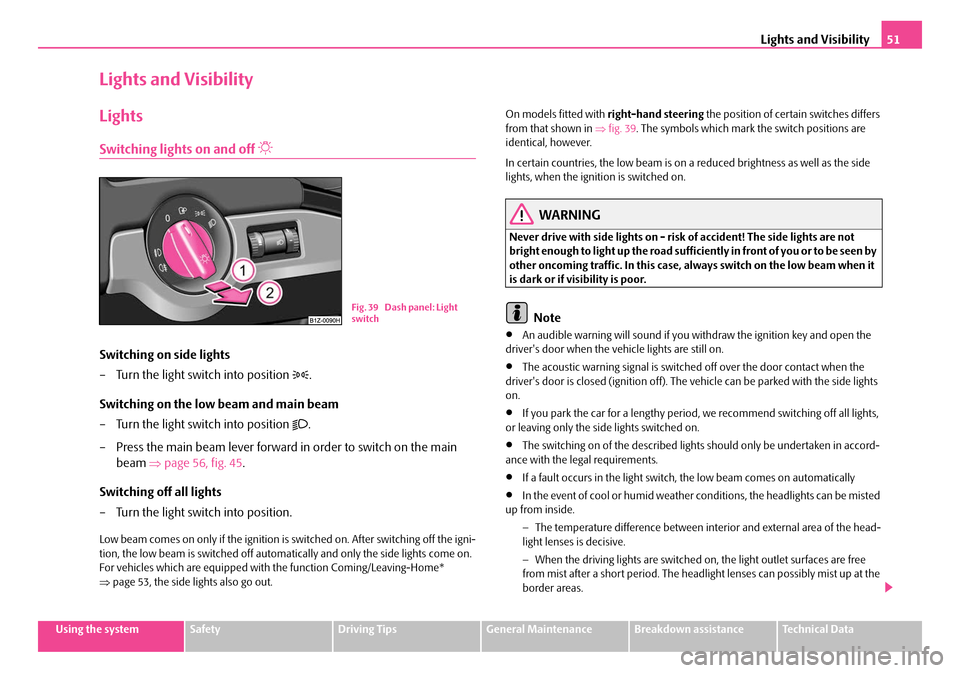
Lights and Visibility51
Using the systemSafetyDriving TipsGeneral MaintenanceBreakdown assistanceTechnical Data
Lights and Visibility
Lights
Switching lights on and off
Switching on side lights
– Turn the light switch into position
.
Switching on the low beam and main beam
– Turn the light switch into position
.
– Press the main beam lever forward in order to switch on the main beam ⇒page 56, fig. 45 .
Switching off all lights
– Turn the light switch into position.
Low beam comes on only if the ignition is switched on. After switching off the igni-
tion, the low beam is switched off automati cally and only the side lights come on.
For vehicles which are equipped with the function Coming/Leaving-Home*
⇒ page 53, the side lights also go out. On models fitted with
right-hand steering the position of certain switches differs
from that shown in ⇒fig. 39 . The symbols which mark the switch positions are
identical, however.
In certain countries, the low beam is on a reduced brightness as well as the side
lights, when the ignition is switched on.
WARNING
Never drive with side lights on - risk of accident! The side lights are not
bright enough to light up the road suffic iently in front of you or to be seen by
other oncoming traffic. In this case, always switch on the low beam when it
is dark or if visibility is poor.
Note
•An audible warning will sound if you wi thdraw the ignition key and open the
driver's door when the vehicle lights are still on.
•The acoustic warning signal is switched off over the door contact when the
driver's door is closed (ignition off). The vehicle can be parked with the side lights
on.
•If you park the car for a lengthy period, we recommend switching off all lights,
or leaving only the side lights switched on.
•The switching on of the described lights should only be undertaken in accord-
ance with the legal requirements.
•If a fault occurs in the light switch , the low beam comes on automatically
•In the event of cool or humid weather co nditions, the headlights can be misted
up from inside.
−The temperature difference between interior and external area of the head-
light lenses is decisive.
− When the driving lights are switched on , the light outlet surfaces are free
from mist after a short period. The headlight lenses can possibly mist up at the
border areas.
Fig. 39 Dash panel: Light
switch
NKO A5 20 MR08.book Page 51 Wednesday, April 11, 2007 2:54 PM
Page 53 of 288

Lights and Visibility
52
− It also concerns reverse light and turn signal lights.
− This mist has no influence on th e life of the lighting system.
Automatic driving lamp control*
Switching on automatic driving lamp control*
– Turn the light switch ⇒page 51, fig. 39 into position
.
Switching off automatic driving lamp control*
– Turn the light switch into position.
If the light comes on when the driving lamp control is switched on, the side lights
and low beam as well as licence plate light light up at the same time.
You can also switch on the side lights, fog lights and rear fog light with the light
switch .
If the automatic driving lamp control* is switched on, the light is controlled by a
light sensor in the mount of the interior re ar mirror. If the light intensity drops below
the set value, e.g when driving during th e day into a tunnel, the low beam and the
side lights as well as the licence plate light come on automatically. If the light inten-
sity increases again, the ligh ts switch off automatically. Motorway lights
If the automatic driving lamp control* has been switched on and the vehicle speed
is over 140 km/h for at least 10 seconds, th
e side lights and low beam are switched
on automatically.
If the vehicle speed is below 65 km/h for at least 2 minutes, the lights are switched
off.
Rain lights
If you move the windshield wiper lever in the position slow wipe for more than 5
seconds, the side lights and low beam ar e automatically switched on. The light is
switched off when the windshield wiper le ver is no longer than 4 minutes in the
position for slow or intermittent wipe.
WARNING
The automatic driving lamp control only operates as a support. The driver is
not released from his responsibility to inspect the light and if necessary to
switch on the light depending on th e light conditions. The light sensor
cannot detect for example rain or snow. Always switch on the low beam
under these conditions as well as when driving in the dark!
Note
•Do not affix any stickers in front of the light sensor, so that you do not impair its
function or put it out of operation.
•The same principles as for using the au tomatic driving lamp control also apply
to the light which is switched on manually ⇒page 51.
Fi g. 4 0 D ash pan el: Lig ht
switch
NKO A5 20 MR08.book Page 52 Wednesday, April 11, 2007 2:54 PM
Page 54 of 288
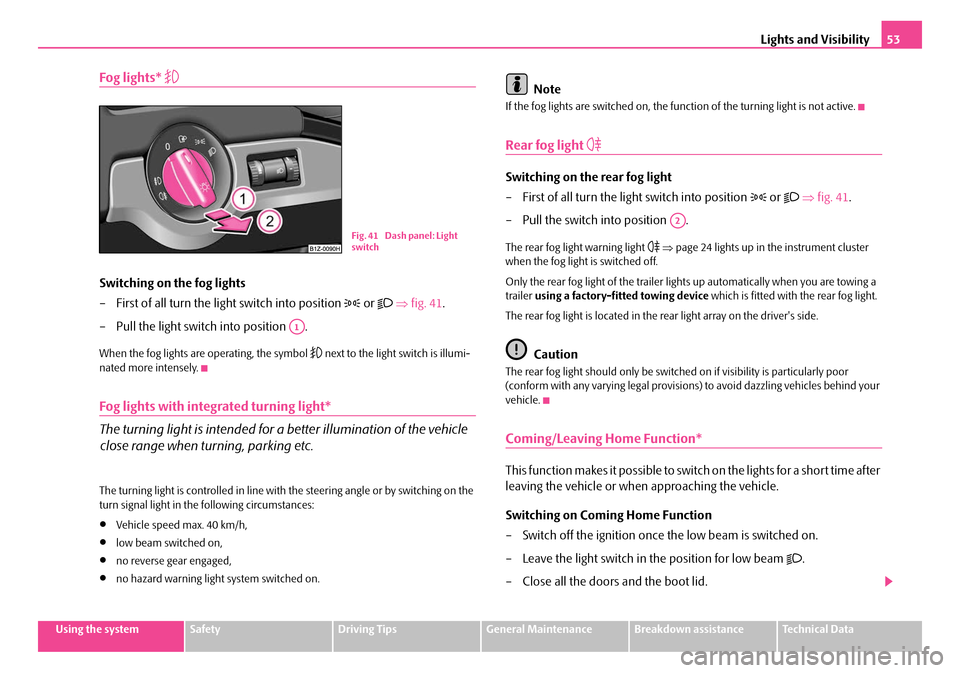
Lights and Visibility53
Using the systemSafetyDriving TipsGeneral MaintenanceBreakdown assistanceTechnical Data
Fog lights*
Switching on the fog lights
– First of all turn the light switch into position
or ⇒ fig. 41 .
– Pull the light switch into position .
When the fog lights are operating, the symbol next to the light switch is illumi-
nated more intensely.
Fog lights with integrated turning light*
The turning light is intended for a better illumination of the vehicle
close range when turning, parking etc.
The turning light is controlled in line with the steering angle or by switching on the
turn signal light in the following circumstances:
•Vehicle speed max. 40 km/h,
•low beam switched on,
•no reverse gear engaged,
•no hazard warning light system switched on.
Note
If the fog lights are switched on, the function of the turning light is not active.
Rear fog light
Switching on the rear fog light
– First of all turn the light switch into position
or ⇒ fig. 41 .
– Pull the switch into position .
The rear fog light warning light ⇒ page 24 lights up in the instrument cluster
when the fog light is switched off.
Only the rear fog light of the trailer ligh ts up automatically when you are towing a
trailer using a factory-fitted towing device which is fitted with the rear fog light.
The rear fog light is located in the rear light array on the driver's side.
Caution
The rear fog light should only be switched on if visibility is particularly poor
(conform with any varying legal provisions) to avoid dazzling vehicles behind your
vehicle.
Coming/Leaving Home Function*
This function makes it possible to switch on the lights for a short time after
leaving the vehicle or when approaching the vehicle.
Switching on Coming Home Function
– Switch off the ignition once the low beam is switched on.
– Leave the light switch in the position for low beam
.
– Close all the doors and the boot lid.
Fig. 41 Dash panel: Light
switch
A1
A2
NKO A5 20 MR08.book Page 53 Wednesday, April 11, 2007 2:54 PM
Page 55 of 288
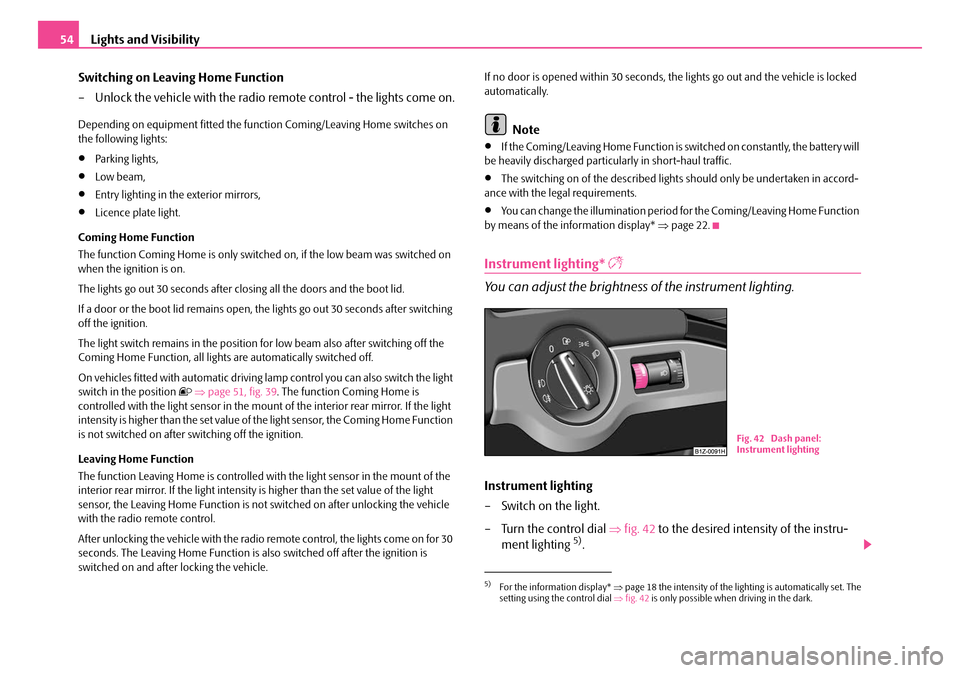
Lights and Visibility
54
Switching on Leaving Home Function
– Unlock the vehicle with the radio remote control - the lights come on.
Depending on equipment fitted the functi on Coming/Leaving Home switches on
the following lights:
•Parking lights,
•Low beam,
•Entry lighting in the exterior mirrors,
•Licence plate light.
Coming Home Function
The function Coming Home is only switch ed on, if the low beam was switched on
when the ignition is on.
The lights go out 30 seconds after cl osing all the doors and the boot lid.
If a door or the boot lid remains open, th e lights go out 30 seconds after switching
off the ignition.
The light switch remains in the position for low beam also after switching off the
Coming Home Function, all lights are automatically switched off.
On vehicles fitted with automatic driving la mp control you can also switch the light
switch in the position
⇒ page 51, fig. 39 . The function Coming Home is
controlled with the light sensor in the mount of the interior rear mirror. If the light
intensity is higher than the set value of the light sensor, the Coming Home Function
is not switched on after switching off the ignition.
Leaving Home Function
The function Leaving Home is controlled wi th the light sensor in the mount of the
interior rear mirror. If the light intensity is higher than the set value of the light
sensor, the Leaving Home Func tion is not switched on after unlocking the vehicle
with the radio remote control.
After unlocking the vehicle with the radio re mote control, the lights come on for 30
seconds. The Leaving Home Function is al so switched off after the ignition is
switched on and after locking the vehicle. If no door is opened within 30 seconds, th
e lights go out and the vehicle is locked
automatically.
Note
•If the Coming/Leaving Home Function is switched on constantly, the battery will
be heavily discharged particularly in short-haul traffic.
•The switching on of the described lights should only be undertaken in accord-
ance with the legal requirements.
•You can change the illumination period for the Coming/Leaving Home Function
by means of the information display* ⇒page 22.
Instrument lighting*
You can adjust the brightness of the instrument lighting.
Instrument lighting
– Switch on the light.
– Turn the control dial ⇒fig. 42 to the desired intensity of the instru-
ment lighting
5).
5)For the information display* ⇒page 18 the intensity of the lighting is automatically set. The
setting using the control dial ⇒fig. 42 is only possible when driving in the dark.
Fig. 42 Dash panel:
Instrument lighting
NKO A5 20 MR08.book Page 54 Wednesday, April 11, 2007 2:54 PM
Page 56 of 288
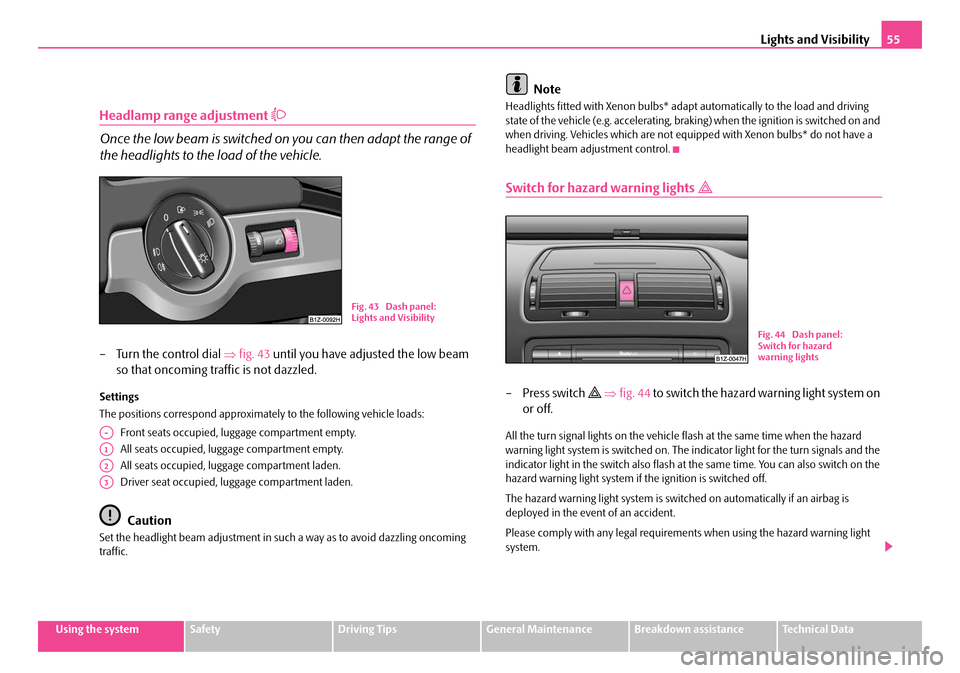
Lights and Visibility55
Using the systemSafetyDriving TipsGeneral MaintenanceBreakdown assistanceTechnical Data
Headlamp range adjustment
Once the low beam is switched on you can then adapt the range of
the headlights to the load of the vehicle.
– Turn the control dial ⇒fig. 43 until you have adjusted the low beam
so that oncoming traffic is not dazzled.
Settings
The positions correspond approximat ely to the following vehicle loads:
Front seats occupied, luggage compartment empty.
All seats occupied, lugg age compartment empty.
All seats occupied, lugg age compartment laden.
Driver seat occupied, luggage compartment laden.
Caution
Set the headlight beam adjustment in such a way as to avoid dazzling oncoming
traffic.
Note
Headlights fitted with Xenon bulbs* adap t automatically to the load and driving
state of the vehicle (e.g. accelerating, braking) when the ignition is switched on and
when driving. Vehicles which are not eq uipped with Xenon bulbs* do not have a
headlight beam adjustment control.
Switch for hazard warning lights
–Press switch ⇒ fig. 44 to switch the hazard warning light system on
or off.
All the turn signal lights on the vehicle flash at the same time when the hazard
warning light system is switched on. The indicator light for the turn signals and the
indicator light in the switch also flash at the same time. You can also switch on the
hazard warning light system if the ignition is switched off.
The hazard warning light system is switched on automatically if an airbag is
deployed in the event of an accident.
Please comply with any legal requirements when using the hazard warning light
system.
Fig. 43 Dash panel:
Lights and Visibility
A-
A1
A2
A3
Fig. 44 Dash panel:
Switch for hazard
warning lights
NKO A5 20 MR08.book Page 55 Wednesday, April 11, 2007 2:54 PM
Page 57 of 288

Lights and Visibility
56
Note
Switch on the hazard warning light system if, for example:
•you encounter traffic congestion,
•your vehicle breaks down or an emergency situation occurs.
The turn signal and main beam lever
The parking lights and headlight flasher are also switched on and off
using the turn signal and main beam lever.
The turn signal and main beam lever perform the following functions:
Right
and left turn signal light
– Push the lever upwards or downwards ⇒fig. 45 .
– If you only wish to flash three times* (the so-called convenience turn signal), push the lever briefly up to the upper or lower pressure point
and release it. This function can be activated/deactivated in the infor-
mation display* ⇒page 22.
– Turn signal for changing lanes - in or der to only flash briefly, move the
lever up or down to the pressure point and hold it in this position. Main beam
– Switch on the low beam.
– Push the lever forwards.
– Pull the lever back into the initial po
sition in order to switch the main
beam off again.
Headlight flasher
– Pull on the lever of the steering wheel (sprung position) - the main beam and warning light in the instrument cluster come on.
Parking light
– Switch off the ignition.
– Push the lever up or down - the ri ght-hand or left-hand parking light
is switched on.
Information concerning the function of the lights.
•The turn signal system only operates when the ignition is switched on. The
corresponding indicator light or in the instrument cluster also flashes.
•The turn signal is automatically cancelled after negotiating a curve.
•The indicator light flashes at twice its normal rate if a bulb of the turn signal light
fails.
•The side light and rear light on the appr opriate side of the vehicle are switched
on when the parking light is selected. The parking light function only operates if
the ignition is switched off.
•An acoustic warning signal will sound when the driver's door is opened if the
lever is not in the middle position after removing the ignition key. The acoustic
warning signal will stop just as s oon as the driver's door is closed.
Caution
Use main beam or the headlight flasher only if this does not risk dazzling other road
users.
Fig. 45 Turn signal and
main beam lever
NKO A5 20 MR08.book Page 56 Wednesday, April 11, 2007 2:54 PM
Page 58 of 288

Lights and Visibility57
Using the systemSafetyDriving TipsGeneral MaintenanceBreakdown assistanceTechnical Data
Note
•Use only in accordance with the legal requirements the described lighting and
signal systems.
Interior lighting
Front interior lighting and lighting of storage compartment on
front passenger side
Switching the interior light on
– Press the switch to the left, the symbol
⇒ fig. 46 appears.
Switching the interior light off
– Press the switch into the middle position O.
– On the version without reading lights press the switch to the right, the symbol O appears.
Door contact setting
– Press the switch to the right, the symbol
appears. – On the version without reading lights press the switch into the
middle position
.
Reading lights*
– Press on one of the switches in order to switch the right or left reading light on or off.
Lighting of storage compartment on the front passenger side*
– When opening the flap of the storage compartment on the front passenger side the lighting in the storage compartment comes on.
– The light switches on automatically when the parking light is switched on and goes out when the flap is closed.
The interior light comes on as soon as yo u unlock the car or open a door or when
the ignition key has been removed. The li ght goes out again about 30 seconds after
all the doors have been closed. The interior lighting is switched off when you lock
the car or switch the ignition on. This on ly applies when the switch for the corre-
sponding interior lights is standing n the door contact setting.
The interior lighting goes off after about 10 minutes when a door has been left open
in order to avoid discharging the battery of the vehicle.
If the switch is in the position
(permanent lights), the interior lighting goes off at
the latest after 10 minutes in order to avoid discharging the battery of the vehicle.
Note
We recommend having these bulbs re placed by a specialist garage.
Fig. 46 Detail of the
headliner: front interior
lighting
AA
AA
AA
AA
AA
AB
NKO A5 20 MR08.book Page 57 Wednesday, April 11, 2007 2:54 PM